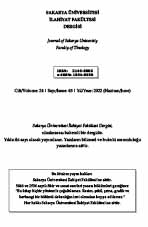Peirce’ün Felsefî Pozisyonunun Gösterge Anlayışına Etkisi
The Effect of Peirce's Philosophical Position on His Understanding of the Sign
Author(s): Şeyma Gülsüm ÖnderSubject(s): Philosophy, Semiology, Logic, Theology and Religion, Islam studies
Published by: Sakarya üniversitesi
Keywords: Logic; Semiotics; Pragmaticism; C. S. Peirce; Saussure;
Summary/Abstract: The difference in mental background, which plays an active role in the scientific analysis of the sign, paves the way for some disagreements regarding the function and purpose of the act of signifying, especially the changes in the shapes and forms of its basic elements. As a matter of fact, the founders of semiotics, Ferdinand de Saussure and C. S. Peirce, consider the sign in two different contexts. While Saussure is content to mention the necessity of establishing semiotics as a branch of science that also includes linguistics, Peirce carries it to the scientific ground with the aim of accelerating the logic and meaning-interpretation studies. Peirce, who developed his own categories of entities, deals with them in three stages. These; firstness, in which the entity is a pure quality before it exists in the world, secondness, in other words, the form in which this quality is embodied outside; and the thirdness, in other words, the state in question, which has gained the ability to serve as a representation in order to appeal to a mind and be interpreted. In this last category, being becomes an interpretable sign that points to an object for a certain meaning. The point where the categories of being and Peirce's theory of sign meet is that the types of sign, object and interpretant are shaped according to these three categories.
Journal: Sakarya Üniversitesi İlahiyat Fakültesi Dergisi (SAUIFD)
- Issue Year: 24/2022
- Issue No: 45
- Page Range: 185-210
- Page Count: 26
- Language: Turkish

